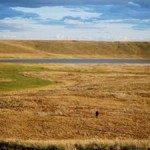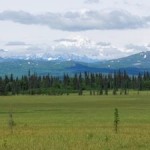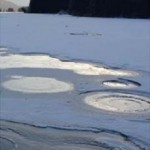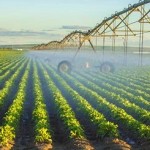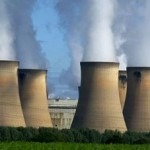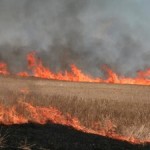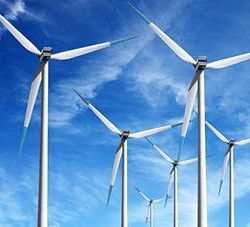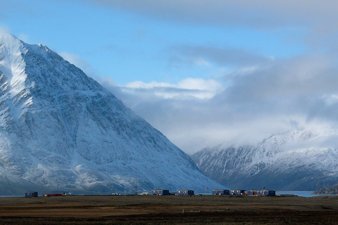
Vast areas on the Northern Hemisphere are covered by tundra. Here, dwarf shrubs, sedges, mosses, etc., thrive on top of permafrost in areas where only the uppermost soil layer thaws during the short Arctic summer.
New studies show that the tundra may become a source of CO2 in the future. Researcher Magnus Lund from Aarhus University explainsm “The soil below the tundra contains very large quantities of carbon – more than twice as much as is present in the planet’s entire atmosphere. Therefore, we would like to know if the carbon will stay put – or if it will be released into the atmosphere as CO2 or methane as the climate warms.”
Since 2000, researchers in Zackenberg in Northeast Greenland have therefore studied the carbon balance by exploring the following two figures:
- The amount of carbon released in the form of CO2 as living organisms respire
- The amount of carbon being stored in plants owing to photosynthesis
Once you have established the two figures, it is possible to calculate if the tundra is a source of CO2 or if it acts as a sink absorbing carbon and storing it in living plants or in the peat layer.
“We can see that the annual release of CO2 from living organisms increases linearly as the temperature increases, measured as the average temperature in July. However, it seems that the ability of the photosynthesis to assimilate carbon stops increasing when the temperature in July rises above approximately seven degrees Celsius, which has occurred several times in past years. This means that the tundra may become a CO2 source if the current strong climate warming continues as expected,” says Magnus Lund, before pointing out that the fear that the tundra can develop into a source of CO2 is based on a very limited number of measurements.
“It’s a problem in the Arctic that we don’t perform measurements at enough locations. The variation between locations is substantial both for CO2 and not least for methane. In Greenland, we measure near Nuuk and in Zackenberg, where we collect measurements from a relatively dry heath and from a moist fen area. A new station is also being established at Station Nord in the northernmost part of Greenland.”
Methane Remains More Important
Magnus Lund emphasises that, in decades to come, from an Arctic perspective, methane will remain the primary contributor to Earth’s greenhouse gas budget. In 2007, researchers from the Zackenberg research station in Northeast Greenland made a surprising discovery: In autumn, when the surface of the tundra freezes and ice is formed, large quantities of the powerful greenhouse gas methane are released. In fact, the quantities released were so large, that the annual methane emissions had to be doubled in the calculation of the tundra’s methane budget.
Methane is a powerful greenhouse gas, its effect is 20-25 times as strong as that of CO2. Methane, therefore, still plays a central role for the research performed at Zackenberg.
Soil Moisture Crucial
Recent studies have shown that the formation of methane is closely linked to the tundra’s water content – as implied by the term “swamp gas”. The more water is present in the tundra, the more methane is formed. And vice versa, where there is less water, the presence of oxygen will provide the basis for formation of CO2. In this way, the soil’s water content plays an important role in determining what will happen with the carbon below the tundra.
Areas that become drier will give rise to increased CO2 emissions, whereas areas that become more moist will cause the emissions of methane to increase. The water balance is affected by the temperature and precipitation, but also by the soil’s content of ice.
Among other things, researchers are now working to establish how and when the methane released in autumn is formed, and if this involves new or old carbon.
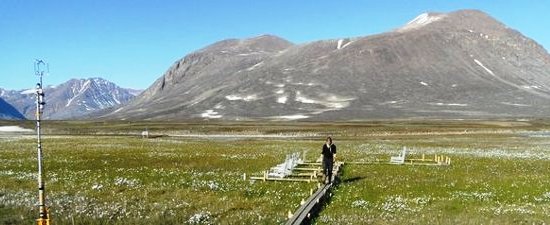
Details of the Studies:
Trends in CO2 Exchange in a High-Arctic Tundra Heath, 2000-2010. M. Lund et al. 2012, Journal of Geophysical Research, vol. 117, G02001, doi:10.1029/2011JG001901, 2012
URL: http://www.agu.org/pubs/crossref/pip/2011JG001901.shtml
Revisiting Factors Controlling Methane Emissions from High-Arctic Tundra. M. Mastepanov et al. 2013, Biogeosciences, vol. 10, 5139–5158, 2013, doi:10.5194/bg-10-5139-2013
URL: http://www.biogeosciences.net/10/5139/2013/bg-10-5139-2013.html
Source: Aarhus University.

